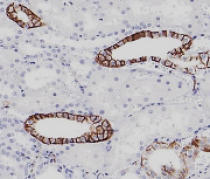ARG67039
anti-L1CAM antibody [SQab30319]
anti-L1CAM antibody [SQab30319] for IHC-Formalin-fixed paraffin-embedded sections and Human
Overview
| Product Description | Recombinant rabbit Monoclonal antibody [SQab30319] recognizes L1CAM |
|---|---|
| Tested Reactivity | Hu |
| Tested Application | IHC-P |
| Host | Rabbit |
| Clonality | Monoclonal |
| Clone | SQab30319 |
| Isotype | IgG |
| Target Name | L1CAM |
| Antigen Species | Human |
| Immunogen | Synthetic peptide of Human L1CAM. |
| Conjugation | Un-conjugated |
| Protein Full Name | Neural cell adhesion molecule L1 |
| Alternate Names | L1CAM, L1 Cell Adhesion Molecule, NCAM-L1, CAML1, Neural Cell Adhesion Molecule L, CD171 , MIC5, Antigen Identified By Monoclonal Antibody R1, N-CAM-L1, HSAS1, HSAS, MASA, SPG1, S10, CD171 Antigen, N-CAML1 |
Application Instructions
| Application Suggestion |
|
||||
|---|---|---|---|---|---|
| Application Note | The dilutions indicate recommended starting dilutions and the optimal dilutions or concentrations should be determined by the scientist. | ||||
| Positive Control | Human Kidney |
Properties
| Form | Liquid |
|---|---|
| Purification | Purification with Protein A. |
| Buffer | PBS, 0.01% Sodium azide, 40% Glycerol and 0.05%BSA. |
| Preservative | 0.01% Sodium azide |
| Stabilizer | 40% Glycerol and 0.05%BSA |
| Storage Instruction | For continuous use, store undiluted antibody at 2-8°C for up to a week. For long-term storage, aliquot and store at -20°C or below. Storage in frost free freezers is not recommended. Avoid repeated freeze/thaw cycles. Suggest spin the vial prior to opening. The antibody solution should be gently mixed before use. |
| Note | For laboratory research only, not for drug, diagnostic or other use. |
Bioinformation
| Database Links | |
|---|---|
| Gene Symbol | L1CAM |
| Gene Full Name | L1 Cell Adhesion Molecule |
| Background | The protein encoded by this gene is an axonal glycoprotein belonging to the immunoglobulin supergene family. The ectodomain, consisting of several immunoglobulin-like domains and fibronectin-like repeats (type III), is linked via a single transmembrane sequence to a conserved cytoplasmic domain. This cell adhesion molecule plays an important role in nervous system development, including neuronal migration and differentiation. Mutations in the gene cause X-linked neurological syndromes known as CRASH (corpus callosum hypoplasia, retardation, aphasia, spastic paraplegia and hydrocephalus). Alternative splicing of this gene results in multiple transcript variants, some of which include an alternate exon that is considered to be specific to neurons. [provided by RefSeq, May 2013] |
| Function | Neural cell adhesion molecule involved in the dynamics of cell adhesion and in the generation of transmembrane signals at tyrosine kinase receptors. During brain development, critical in multiple processes, including neuronal migration, axonal growth and fasciculation, and synaptogenesis. In the mature brain, plays a role in the dynamics of neuronal structure and function, including synaptic plasticity. [Uniprot] |
| Cellular Localization | Cell membrane, Cell projection, Membrane |
| Calculated MW | 140 kDa |
| PTM | Disulfide bond, Glycoprotein, Phosphoprotein. [UniProt] |
Images (1) Click the Picture to Zoom In






